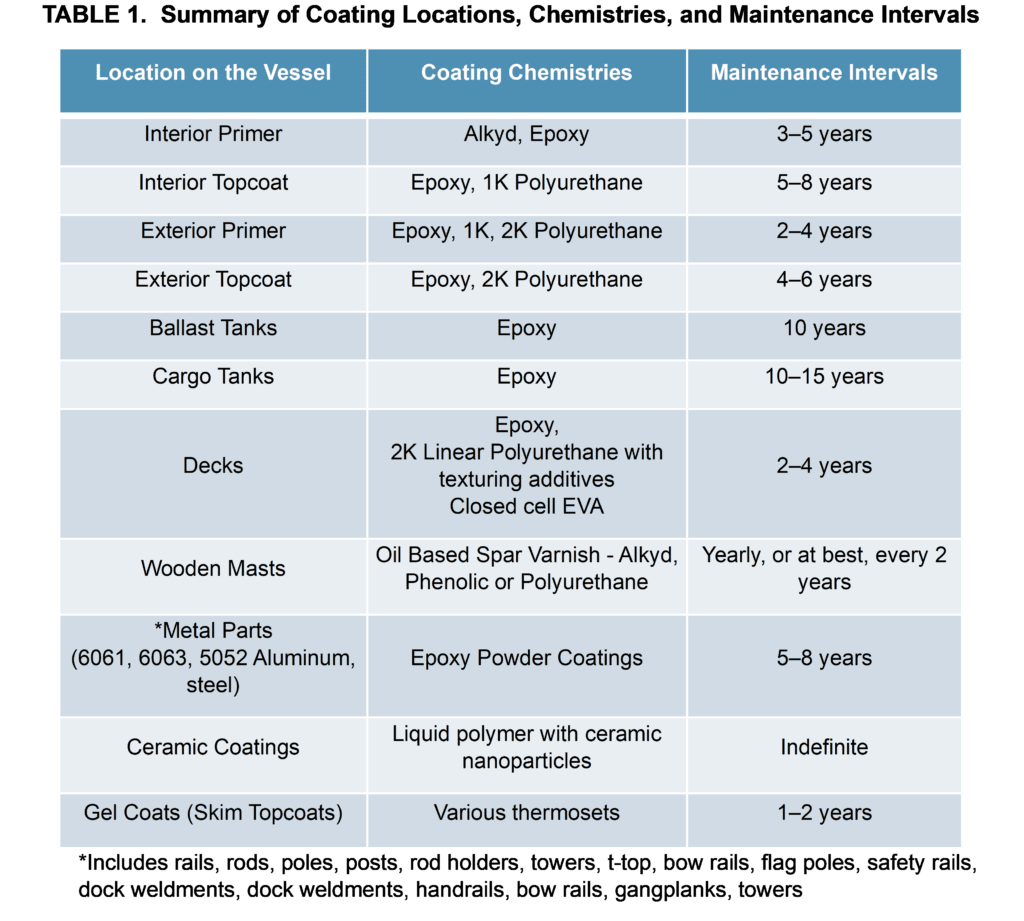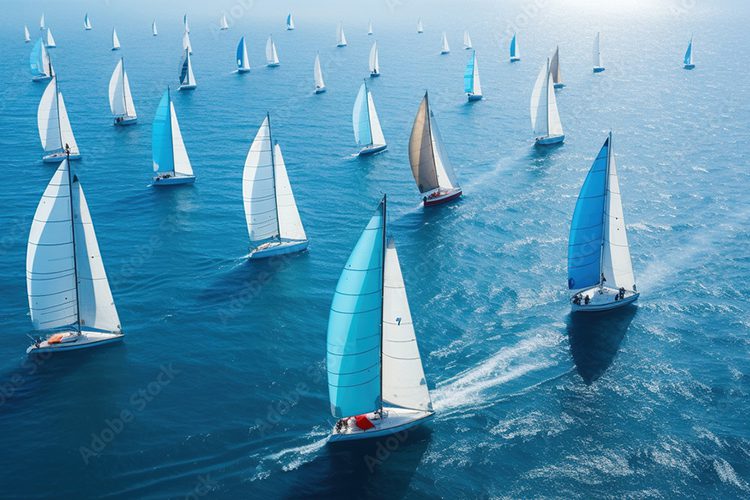Editor’s note: This is the second in a series. Read Part One in the September-October CoatingsTech.
By Cynthia A. Gosselin, Ph.D., The ChemQuest Group
As discussed in Part One of this two-part series, it is quite the technical feat to develop marine coatings and methods that keep the submerged portion of the hull free from sea creatures and corrosion without also destroying everything in the vicinity. The many efforts underway to accomplish this are represented in the fact that 64% of the $8.7 billion marine paint market is dedicated to this endeavor. The complex underwater scenario is rarely seen by spectators watching yachts, fishing boats, sailboats, and commercial shipping vessels sail majestically away to their maritime adventures.
What is seen is the part of the boat that is above the waterline. The beauty and majesty associated with boats is represented by topside coatings that impart gleaming paint jobs that are the icon of yacht-quality maintenance—and the goal of all boat owners. Aesthetics are very important and affect the ranking and resale value of a vessel.
Topside paint is, technically speaking, not considered “as important or complex” as bottom boat paint, but it does provide corrosion resistance and significant protection against UV rays. Weeks of sun exposure without “sunscreen” can damage the surface of boat hulls and gunwales just as dramatically as skin can sunburn and blister.
Topside coatings are formulated specifically for the substrate to be painted. Many modern boats have fiberglass hulls, but there remains a significant market for wooden boats among enthusiasts, classic boat owners, and traditionalists.
From Air to the Sea
The genesis of modern topside boat paint occurred in 1973 when two Eastern Airline pilots persuaded Merritt Boat & Engine Works to paint their boats with a coating called Alumigrip that, until now, had only been used on planes flying at 450 knots (517 mph). The coating seemed immune to UV degradation and was extremely hydrophobic. The results were so stunning that US Paints decided to market the product for the marine industry.
Through a series of bar discussions and poor handwriting, Alumigrip became Awlgrip —perfectly (albeit accidentally) named for the marine industry. The new coating process consisted of an epoxy primer and a sprayed linear-polyurethane coating. Ted Turner, winning the 1977 America’s Cup in a record four-race sweep sporting a beautiful Awlgrip topcoat, propelled this coating technology to the top of the marine world. Since then, polyester and acrylic-modified polyurethane topcoats have been added to the product line, providing the same UV and corrosion resistance and hydrophobicity of the original experiment. In the 50 years since the inception of this product, it has become the go-to paint system for the marine and yacht market.1
Liquid Coatings
Today’s maritime world still has expensive yachts, wealthy boat owners, and less-than-handy boat enthusiasts that commission commercial painting and maintenance for their vessels using only the top-of-the-line coatings. But similar to other industries, the Do-It-Yourself (DIY) philosophy has taken root because of the wildly fluctuating and increasing prices (much to the dismay of boat refurbishing companies).
Paint companies have responded to the DIY demands by simplifying paint systems that provide glossy finishes and decent durability. One-part modified alkyd enamels, urethanes, and two-part simple mix products line marina supply and big box store shelves. If properly applied, the aesthetics are excellent. With some routine maintenance, durability is good enough.
In addition to aesthetics and durability, ease of application is a prime consideration of the DIY consumer. Of course, while the roll-and-tip finish will never rival a PRO-sprayed finish, the results from today’s formulations can be very good.
Several of these formulations generate little sagging and dripping, which is the bane of improperly applied high-end coatings. The caveat is that the instructions for surface preparation must be carefully followed, the owner has a modicum of sanding and buffing skill with the requisite amount of patience. Boat refurbishing companies hide their grins when someone comes in for a full paint repair because they “knew how to paint and didn’t need directions.”
In fact, many PROs that mentor DIY novices suggest first painting oars with the paint system that will be used on the boat hull. This provides insight into the behavior of the paint and more importantly, the actual skill and ability of the painter.
 The chemistries used to either commercially or DIY paint new or refurbished boats include alkyds, epoxies, and polyurethanes for interior and exterior surfaces. Table 1 provides the typical paint systems used for various boat locations with the projected maintenance intervals.
The chemistries used to either commercially or DIY paint new or refurbished boats include alkyds, epoxies, and polyurethanes for interior and exterior surfaces. Table 1 provides the typical paint systems used for various boat locations with the projected maintenance intervals.
Powder Coatings
Powder coatings are used in a huge variety of applications, including boating and marine equipment. These types of coatings are not as widely used as liquid systems, primarily because they are more difficult, if not impossible to repair without completely removing the existing coating. However, there are some advantages to using powder coatings on metal surfaces—particularly for ladders, stairs, rails, flag poles, and such items. Metal, unlike fiberglass or wood, tends to corrode if there is a poor barrier layer between the surface and the environment. The higher powder coating film thickness, together with complete coverage, provides this advantage.
Salt particles are highly corrosive to common powder coatings. If not formulated specifically for marine applications, salt will permeate the coating over time, causing it to powder and break down. Marine powder coatings are typically made from specialized resins and additives that provide for durability, flexibility, water resistance, UV resistance, and even antifouling properties. In addition, these powders use different media—glass beads, coarse and medium sand, etc.—to generate a variety of textures. Powder coatings also have good chemical resistance to most of the types of exposures that boats can encounter even in relatively clean water.
Powder coatings can be applied to a wide variety of substrates, which helps in reducing corrosion on the metal parts throughout the boat. Epoxy and modified epoxy powder coatings are the oldest and still most widely used for this application. They are considered to be “surface tolerant” by many repair shops because of good adhesion to minimally prepared surfaces.2 Many South Florida boat owners choose powder coatings for their metal boat parts because the surfaces maintain their luster and shine without needing constant attention.
Other structures located at or very near the coast or off-shore also benefit from powder coatings. Reliability and durability are critical for metal structures that are exposed constantly to the environmental attack of seaspray, humidity, and sunlight. Powder coatings used for these applications provide protection from these elements.
These coatings are governed by standards such as ISO 12944-5:2019. This standard lists environment classifications and provides guidance as to the types of coatings that have been proven to perform well within those boundaries. Suggestions for testing are also provided. Powder coating chemistries and film thicknesses for metal on boats, shoreline, near shoreline, and sea structures are part of this standard.
Rigorous accelerated and real-time cyclic testing has verified long term durability, corrosion resistance and extended surface aesthetics for marine applications. Marine powder coatings must perform well in Corrosion Classification C5M–Very High Marine, which encompasses on shore and offshore areas of high salinity. Buildings in this classification are almost always subjected to constant condensation and high environmental salt contamination as well.3
Typical accelerated testing for marine products includes ASTM G85 Salt Spray and Salt Fog Testing: Annex 1—Acetic Acid Salt Spray Test (non-cyclic) or Annex 3–Seawater Acidified Test (cyclic).
In addition, real-world testing is also required in order to ensure that the corrosion mechanisms are not artificially test-induced, but actually occur in the ascribed environment. Florida exposure testing includes 72 hours of accelerated UV exposure, 72 hours of neutral salt spray exposure, and 24 hours low temperature testing at -20 °C. This cycle is repeated 25 times (4,200 hours) to ensure that the paint systems on metal substrates ultimately exhibit the necessary durability.4
Deck Coatings
A necessary safety feature on boats is a skid-resistant deck. No boat owner wants to take the chance that a purported non-skid deck paint loses gripping power and someone ends up overboard. The substrate determines the decision to prime the deck surface. If the deck is wood or bare metal, a primer is crucial. If the deck is wood, a sealer is required. The best primer is a 2K epoxy because it provides more durability and hardness than a one-part system.
The easiest topcoats to apply are one-part paints containing non-skid additives—with the caveat that they be mixed well for an even application. The 2K linear polyurethanes will last longer and stay cleaner than textured paints or one-part coatings. For higher-end paints to perform better, more care must be taken during application. Professional boat refurbishing shops will generally spray-apply polyurethane. Following the application of the textured layer, multiple thin coats are applied to seal the surface. The 2K linear polyurethanes last at least five years and, in the right environmental conditions (rainy and cloudy versus constant sunshine) can provide good service for up to 10 years.
Wood Coatings
Aluminum is taking over as the preferred mast material for modern sailors. But many classic boat owners, traditionalists, and boat enthusiasts love the aesthetics of a wooden mast—even though it requires much shorter maintenance intervals than all other topside paints. Most topside wood paints lose gloss, color, and durability after only two years—but every sailor should check the mast every year. Furthermore, because masts, spars, and tillers see the most banging of any wood component on a boat, chip- and abrasion-resistance are also important coating characteristics. In fact, clear coatings are preferred on masts because cracks, fungus, wood rot, dings, and chips are visible very early—helping to avoid significant damage or a sailing disaster. Paint tends to hide cracks and seams where water can penetrate, causing unseen deterioration due to moisture ingress. These spar varnishes also tend to be soft and flexible, adapting to the expansion and contraction due to hot, dry, cool, and wet weather cycles without cracking.5
There is a one-part, self-crosslinked system with outstanding weathering properties. It is safe for application both above and below deck because there is virtually no odor, it has low VOCs, and it is non-toxic. It contains three UV-stabilizers, does not yellow, and is mold and mildew resistant. It flexes with the wood to prevent cracking—providing longer durability. The formulation allows for cleanup using only water.6 Heightened consumer environmental awareness, especially relating to waterways, will spur coatings developers to make more environmentally compatible coatings available in the future.
Topside coatings are a very well-developed genre of marine coatings because serious boat owners understand that the eye-catching, gleaming appearance of a well-maintained boat is really a beautiful cover for a tough preservation imperative for long-lasting enjoyment in the ironically corrosive environment of beautiful lakes and seas.
References
- Awlgrip website. “1973—From Planes to Boats.” https://www.awlgrip.com/fiftyyears/1973-from-planes-to-boats (accessed September 12, 2023).
- Coatings Systems Inc. Benefits of Marine Powder Coatings for Boats. November 20, 2017.
- International Standards Organization. 2019. ISO 12944-5:2019 Paints and varnishes—Corrosion protection of steel structures by protective paint systems—Part 5: Protective paint systems.
- Northpoint Ltd website. Anti Corrosion. “What Is Marine Grade Powder Coating?” https://www.northpoint.ltd.uk/2021/08/26/what-is-marine-grade-powder-coating/ (accessed September 24, 2023).
- The Wood Whisperer. “Difference Between Spar Varnish and Regular Varnish?” October 20, 2008.
